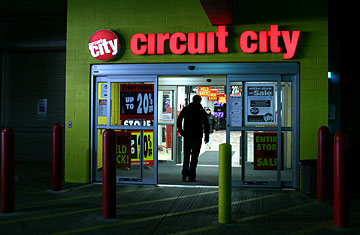
A customer walks into a Circuit City store in Chicago. The nation's second-largest consumer electronics retailer filed for Chapter 11 bankruptcy on Nov. 10 and plans to close 155 of its stores and cut 17% of its workforce
Be careful whose gift cards you buy this season. As retailers struggle with recession, debt-laden consumers, unfriendly bankers and declining property values, fewer of them will be around next year. "By the end of 2009, the number of retail players will be down by at least 25% and could be down by as much as 40%," says Britt Beemer, chairman of America's Research Group, a consumer-research and marketing firm based in Charleston, S.C. "I expect the number of bankruptcies next year to be more than we've seen in the last five years combined."
Already, some 20 retailers have sought bankruptcy protection this year, with such household names as Circuit City, Steve & Barry's, Linens 'n Things and Mervyns going under. Of those four, only Circuit City is attempting to restructure its business, closing 155 stores by the end of the year in an effort to emerge as a leaner operation. The other three plan to liquidate altogether, a trend that is on the rise as a result of the lack of potential buyers for troubled assets and a tightening of credit offerings by banks. "The days of restructuring are gone," says Howard Davidowitz, chairman of Davidowitz & Associates Inc., a national retail-consulting and investment-banking firm. "No one will give you the financing." (See pictures of the global financial crisis.)
For store owners big and small, 'tis the season of sweating brows. U.S. retail sales dropped a record 2.8% last month, just the latest in a string of bad months. By the end of 2008, 148,000 retail establishments will have closed, the largest number since 2001, according to the International Council of Shopping Centers. A rough holiday season will produce an additional 73,000 store closings in the first half of 2009, the council predicts. "In the first six months of next year there will be a lot more retail museums than retail stores," says Beemer.
Regional department-store chains in smaller to midsize cities are already under pressure, but some have an extra heap of woe. Women's retailer Bon-Ton faces a double challenge: softening sales and a mountain of debt resulting from its $1 billion buyout of 142 stores from Saks two years ago. Even powerhouse Dillard's, with stores spread across 29 states, is raising anxiety owing to weakening sales, down 10% for the quarter. In early November, Standard & Poor's lowered its corporate credit rating of Dillard's to B+ from BB-, citing the "deepening spending pull-back by consumers." Adding to the drama, hedge-fund investors Barington Capital Group LP and Clinton Group Inc. called for William Dillard II, the chain's CEO, to step down amid declining revenue and a stock price that has lost more than 70% of its value. The good news: "They aren't leveraged like other stores are," says Beemer. "But if you look at mall-based apparel stores, any of them could be in trouble except for Victoria's Secret, which has a good customer base." (See 10 things to do with your money.)
Hopes for upscale retailers are fading fast. The high-end customer is cutting back spending 9 percentage points more than the overall consumer, according to America's Research Group. One victim of the trend: Saks Fifth Avenue, which saw a devastating 16.6% sales plunge in October, coming on the heels of a 10.9% drop in September.
Other specialty merchants in troubled waters include Talbots, the conservative women's clothing boutique, whose same-store sales plunged 14% in the third quarter. "In their case it might be an overexpansion problem as they got into men's and children's clothing and then made the acquisition of J.Jill, which wasn't smart," says Neil Stern, senior partner at McMillan Doolittle, a Chicago-based retail-consulting firm. That half-billion-dollar acquisition is currently up for sale, but no one is biting. Meanwhile, outdoor-apparel shop Eddie Bauer emerged from bankruptcy in June 2005 with a $450 million bank loan, which left it highly leveraged and low on cash. "While their same-store sales are down only 1.1% and they're performing pretty well compared to the rest of apparel retailers, it's difficult to do a turnaround in a bad market," says Stern.
Still, there are a few bright spots this Christmas season. Urban Outfitters Inc. has distinguished itself with stylish merchandise that stands out, while teen retailers Aéropostale and Buckle have posted positive same-store comparisons by offering good value. Says Davidowitz: "You have to be either really cheap or really different and really right to do well in this market."
